You may avoid conflict, and measure your words to please others. Or the other way around: nothing better than a good and healthy fight! Maybe you’re sick of all the fighting between your children; you’ve had enough of having to mediate on who gets the plastic glass with the blue stickers. How can you learn to manage an argument in a positive way? How can you help your kids solve a conflict without the yelling and the crying? Let’s take a look here at some very useful strategies for all ages!
Table of Contents
A regular fight
We’re finally home, a quiet afternoon. While I’m putting our groceries away, I see my daughter throwing a delicate rose blanket and a pillow on the hallway’s floor.
She plays for a few minutes on her improvised bed, and then she goes to her room.
Her brother, who was busy pulling a lighted turtle, silently takes his sister’s place. He makes a cocoon with the blanket, holding his Teddy Bear.
Ah! Ain’t it great when the kids learn how to play on their own and I can take the time that I need around the house?
I should have known better. It’s called Murphy’s Law. My daughter gets out of her room. Pay attention as the scene unfolds fast:
She stops, seeing her brother on the blanket. Then regains her posture, runs to him and hits him.
I had it first!
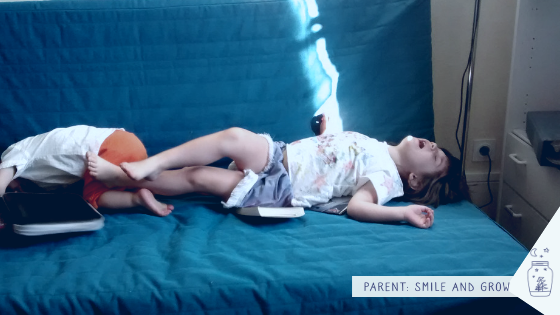
She pulls the blanket, but as her brother is on it she can’t take it away. She pushes him hard until he falls off. They start pulling each others’ hair, until my daughter finally can get a full hold on the blanket. Only to be called to order by
-
Her brother’s desperate crying;
-
her mother’s stop.
He started it Mom! I put so much effort to get everything done and he ruined everything!
Children arguments and parents’s reactions
First instinct : taking sides. I, for instance, can’t stand aggressive behavior as a mean to solve a conflict, no matter the cause..
Second instinct : disciplining, either by scolding or by punishing (or a combination of the two, why not?)
Third instinct : yelling and losing our temper. “I can’t even leave you on your own for 5 minutes without you fighting and hurting yourselves!”
Have you tried one of these techniques?
I get mad, with my daughter at first, because of her violent manners. It’s been a while that she’s so aggressive with her brother, and bursts with anger as soon as she doesn’t get what she wants.
She argues, of course; she believes she has some valid reasons justifying her behavior. I get angry, she yells, I yell, “to your room!” Some crying. Then, the reconciliation.
Has all this avoided a new fight?
Of course not..
The Ladder of success
A few days later, a little discouraged by my daughter’s reactions, my gaze falls onto a small poster hanging on the school’s walls. “The Ladder of success”, it says.
At the center, a Problem; in the upper part, in green, there’s a series of strategies to positively solve a conflict. In the bottom part, in red, the strategies leading to a negative resolution, up to the use of violence.
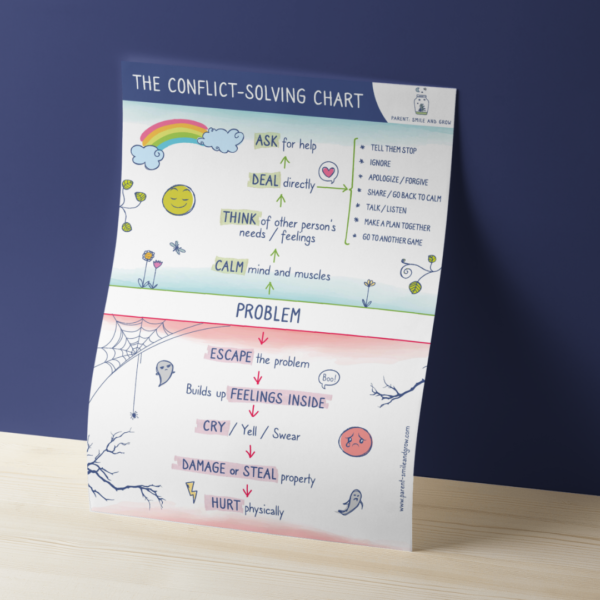
But you know, what stroke me wasn’t the possibility of explaining all this to my daughter. Actually, it seemed too complicated for a kid her age.
No, what I noticed was that I could just see myself into so many of the “red-listed” choices:
-
escape the problem. Wasn’t it what I would do every time somebody would ask me something I wasn’t willing to do? But since I’m afraid of conflict, I would do it anyways?
-
yelling or crying. Like when I’m fed up with my kids fighting and I start yelling “Stop yelling!!”
-
without mentioning the occasional spanking (which I hate, but whose thought has sometimes crossed my mind)..
Am I even able to manage a conflict? Not to avoid one, but to manage it as a big girl who knows how to assert herself in a positive way.
I found the idea of a poster was genius, as I could visually get all the possible choices when facing a conflict, and the direction each would have led me.
So, am I a model for my kids in terms of managing a conflict? Or maybe they don’t know how to deal with it, since I don’t offer such a good example?
Connected : Do you know how to say no?
Asking the right questions
Let’s reconsider our usual strategies:
Whenever we yell, we take sides, or we punish, what are we doing, really?
We’re reacting automatically, pursuing the goal of :
-
-
-
Stopping the situation we don’t like.
-
Feeling back in control. I’m the one who’s in charge of saying who’s right and who is wrong.
-
Releasing our own frustrations.
This reaction only works in the short run.
(As I learnt that for a lasting solution, well.. you need to plan ahead, instead of reacting!)
What do you want to obtain?
(Personal question you need to ask yourself)
Some calm around the house (short-term solution; sometimes necessary when we’re about to explode);
or rather that your kids learn some useful strategies to solve any conflict (long-term solution)?
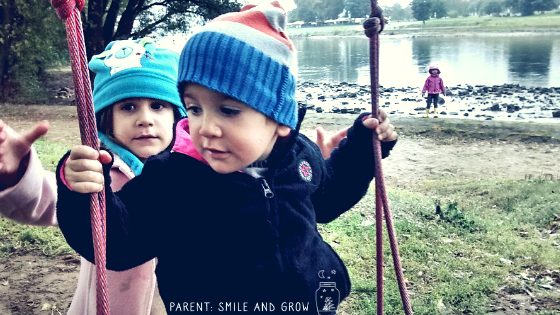
The ideal Solution : children who can always find a compromise without yelling! Unfortunately, the long term solution is also the most costly on the spot! You need to reconsider your own behavior.. But since I’d had enough of having to calm down my son after his sister’s hitting, or of seeing me yell uselessly.. I needed to give it a try.
-
-
1st Step to help your kids solve a conflict : Neutrality
The first thing I learnt is that it’s better to stay neutral. There are two main reasons for this:
-
On one hand, this teaches your kid to count only on his own strengths. I had to realize that my son ended up calling me as soon as he’d sense a fight with his sister, not even trying to tell her what he did’t like. Now, in real life, we won’t always be there to handle our kids’ crises..
-
The aggressor often has a reason behind his aggressive behavior. Jealousy, or a reaction to some accumulated tensions..
When we take sides, we reproduce a “drama triangle” where each person plays either the role of the victim, persecutor or rescuer.
This psychological game reinforces some unconscious beliefs that you reproduce during your life:
- I am only when I exert some control on others (the persecutor);
- I am responsible for others, I neglect my own needs to feel useful (the rescuer);
- or I exist only if I can show my sufferings (the victim).
When you intervene during a fight between our kids, you take on the role of the rescuer for the victim; but when you punish one kid without taking into consideration his point of view, you take then the role of the persecutor, and the kid becomes the victim…
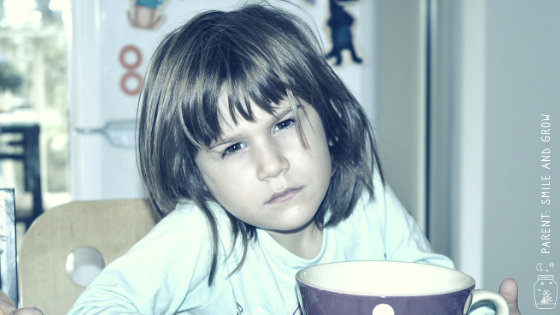
Besides, you may forget to consider your inner schemes. For instance, if you have a tendency to favor one of your kids, or girls rather than boys, or the oldest one etc..
Finally, there’s one last advantage for non getting involved with children’s disputes. With time, they’ll learn that it’s useless to come seek your help, and will start managing on their own.
2nd Step to help your kids solve a conflict : modeling a time-out
That’s what’s most complicated.
You know when your kid has one of those big meltdowns, for instance when he’s tired and you dare refusing yet another piece of chocolate?
He cries, screams, hits and there you are, trying to explain “You ate too much of it honey, it’s not good for you. You can have some more tomorrow.”.
Only, he’s so overwhelmed with his own emotions, that he can’t listen to what you say. So it’s your turn to get mad..
Your kid is just “drunk” on emotions: it is impossible for him to reason and gain control over his neo-cortex, as long as he hasn’t calmed down.
The same happens for us, the only difference being that our kids’ neo-cortex isn’t fully developed yet.
Disputes very often are originated by something that made us lose control, where we can’t control our emotional reactions.
When we fight with our partner it’s often the end of the day right? We need to release all our tensions.. Are you able to say: “Stop. I need some time out to calm down before we can talk.” ?
Now, this is KEY to any problem: calming body and mind, before we can react.
I try to teach all this to my children, by asking them to find an isolated place where they can calm down on their own (or with my help).
But I also realized that I don’t give the good example. I believe that being able to say: “I’m going to lay down for 5 minutes to cool off ” would be much more effective than a thousand explanations.
Connected : 5 Secrets to get your kids to cooperate; and how to accept your children’s emotions
3rd Step to help your kids solve a conflict : control your words!
If you want to stay neutral and give the good example, you also need to choose the words you use.
Because behind certain exclamations, critiques and judgments may hide.
Disputes represent a perfect learning opportunity! Instead of showing intolerance or contempt, you can rejoice for such a chance! 😉
Key words for me are : choice, responsibility, and rules. Let me explain.
When your angle reacts by hitting his sister, he made a poor choice. He’s not a bad kid (beware of labels!), but he didn’t choose the right strategy.
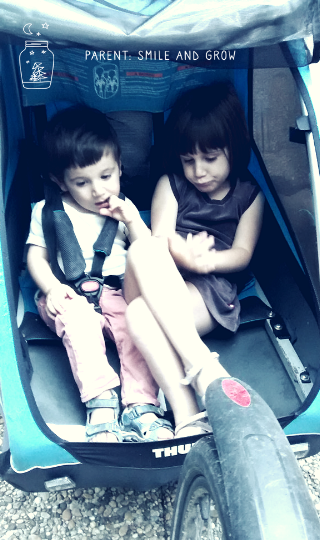
You can tell him! You can describe the situation, and then ask: “What could you have done differently? Which were your options? What did you choose? Were there other choices?“
If we want to help our kids solve a conflict, it’s very useful to have them think about their choices, as well as search for solutions.
What can you do to make up for your bad choice? What solution can you find to share this toy?”
A useful trick that I use often is to have the kids remind me of the rules. Before going on a play date for instance, you can ask: “Which are the rules to play well together? What can you do when your friend wants to play with the same train you want to keep for yourself?” letting the kids answer.
When a “bad choice” happens, it’s going to be a lot easier for you to remind them of the broken rule, and eventually to decide together on a consequence.
4th Step to help your kids solve a conflict : describing
This final step integrates the previous ones.
Your goal? Getting used to establishing empathetic connections and identifying one’s and the other person’s needs; and teach the kids how to do it.
Therefore, when your kiddo calls you to settle an argument with his sister:
If you witnessed the scene, describe what you saw, before you let every child express oneself;
If you weren’t there, make sure every child has a chance to say what he feels about what happened.
Finally, repeat aloud both points of view. This will ensure two things: that each child feels understood (and this will immediately help release the pressure); and that they get a chance to see the other person’s point of view (which will help them find a solution).
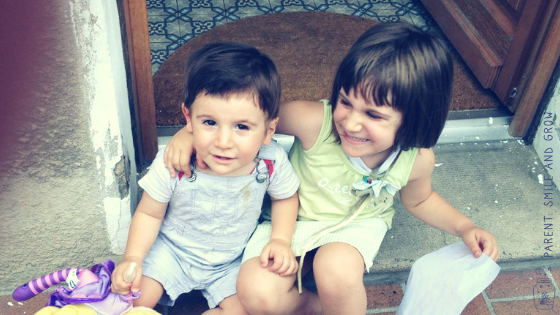
Conclusion
When we see our kids fight, we would want them to stop, to get along.. But we forget that disagreeing, being different and fight for one’s right (in terms of attention or property for instance) is just plain NORMAL!
They learn how to defend and affirm themselves, and they learn the advantages they can get when they cooperate.
So instead of avoiding a conflict, or punishing it.. let’s take advantage of this great life lesson!
This will teach our kids that they have the right to express their disagreement and their difference, and how to do it respecting the other person as well.
It teaches them that we all have a choice, and that we can get better every day.
But how can you start?
-
First of all, you can print and use this poster, which can help you give even your little ones some practical strategies to learn how to solve a conflict.
-
When one of the children does not want to lend his toy, it is counterproductive to force him. If they are too young to look for solutions, a good alternative is to give the child a special mission to please you and make him feel responsible.
-
You can suggest role plays where you play the child, showing him through the game and in a funny way the available options to solve a conflict.
-
Give the example! It is never a good idea to argue with your partner in front of the kids, but if it ever happens, it’s a good time to show them the “right techniques” (or explain the bad ones afterwards)
A visually stunning poster to help your kids memorize their strategies, you can get it here!
Resources and references
I share with you some articles that I have taken as a reference, and useful readings as always! Links to Amazon in this page are affiliate links.
But first, I ask you 3 things:
-
Share this post if you found it useful!
-
What do you think? I’d really like to hear about your experience 🙂
-
You liked the article and you’re interested in joining the club and receiving food for thoughts and inspiring suggestions directly in your inbox? It’s over here!
Articles :
-
For kids only, this page is packed with advice for your children on how to solve a conflict.
-
I fell in love with this post : it is truly very complete, packed with resources and useful advice, easy to read and entertaining.
-
If you want to look at conflict resolution strategies within the classroom setting, you’d better read this post. It’s full of real-life examples of class’ interactions and of advice on how to handle the situation in a way that empowers children in finding their own solutions.
-
These 10 tips for solving a conflict are very useful for any adult and any relationship, but especially for couples.. So that you can be an even better model for your child!
Books :
-
Peaceful Parent, Happy Siblings: How to Stop the Fighting and Raise Friends for Life” is a guide on how to help your children create and maintain a solid bond, minimizing the annoying fighting.
The skills you help your child to cultivate can be great also in different settings, with school friends and any other relationship
-
How to intervene when your children fight? “Siblings Without Rivalry: How to Help Your Children Live Together So You Can Live Too” helps you deepen this sometimes difficult aspect of your parenting life.
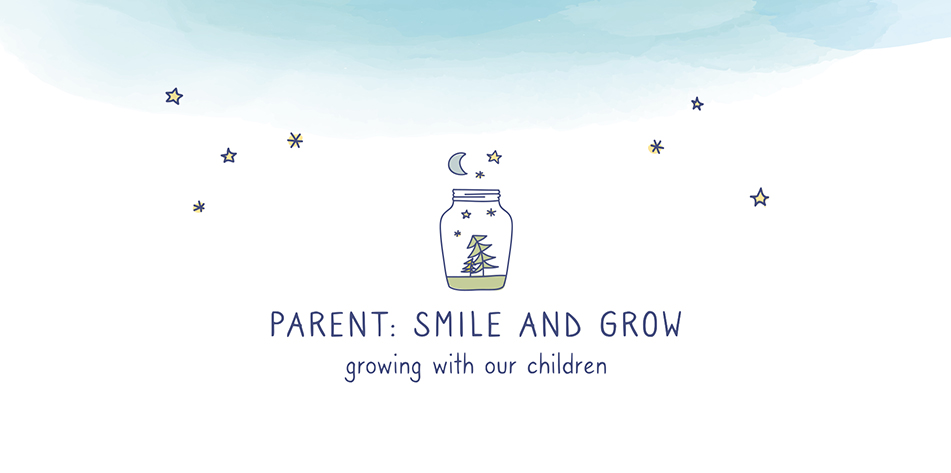
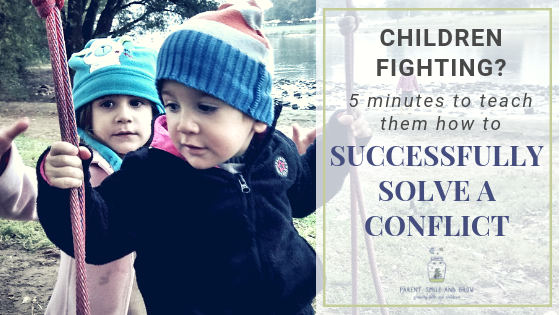


Where was all this advice and wonderful tools when I was losing my mom-shit? This is a great post and I love the printables too! I need a mom-do-over for sure!
When my brother and I would fight, my mother would tell us to go fight it out somewhere else. Whoever survived, she’d keep. I feel like your post is a far better strategy. Because it teaches conflict resolution, and that is so important to not only kids, but adults too.
This is very indepth and a comprenhensive guidelines for all parents. It needs a lot of edication, maturity and awareness on the part of parents to allow the kids to solve their own conflict, and to remain calm and neutral. Most of the times we fail and get carried away and end up supporting one of the kids.This post has some great insights for all parents.
I used to be really aggressive towards my younger brothers as a kid, maybe it was a way I thought I could assert my dominance or something idk it was really silly. We don’t fight nearly as much and it’s really important for young kids to learn conflict resolution so they can be responsible adults.
Great tips here. Children see you more than they hear you, and sometimes, your approach to conflicts mold their too.
Love your insights about this! When I was teaching in the preschool, our core principle in teaching the children to resolve conflict is to walk them through it and figure their way out either to compromise or what.
I loved this article! As an aunt to twin boy and girl it is something else when they ‘fight’ but I’m learning that it is just them learning each other and themselves. Conflict resolution is so important and I love how they do try to be better to understanding to each other in the end.
I read an article recently on how Eskimos approach child rearing. They come from a non-confrontational standpoint and never raise their voices or even discipline. I would like to fall somewhere right in the middle and be a gentle scolder. lol!
Wonderful post, how we deal with these conflicts is a huge part of how we structure our kids as they grow older and staying calm will be a big help for them.
Such great tips, wish I had them when our kids were growing up. A useful article and am sure it will be of great help to my cousins who both have boys of the same age and whenever they get together fight over everything.
As much as we try to avoid it, conflict is a normal part of life. Helping children learn to manage conflict effectively will also help them to experience more fulfilling friendships and enjoy better social experiences, both at school and outside of it. great tips thanks
It’s amazing how many of my 13-14 year old students can’t handle their own conflicts without involving an adult. These are great tips. You are so right–they will never learn to stand up for themselves and solve their own problems unless the adults let go and stand back. A visual would really be helpful for these kids.
These are such great tips! If we as parents aren’t able to manage ourselves in a conflict, how can we expect our young children to do something so emotionally complex?
Fantastic post. Kids need us to model behaviour for them and these are great tips to help us and them.
You are giving some excellent pointers here. I remember watching my niece and nephew grow up – the number of fights between them. Oh my…I’m sure my sister would have appreciated this post back then.
I love this post. My girls are older now but we still have conflicts. Mostly about my youngest “borrowing” my older daughters stuff without asking. I am guilty of some of these things both when they were young and even now that they are older. I’ll give this a try. Also going to pass it along to my wife. Thanks for posting